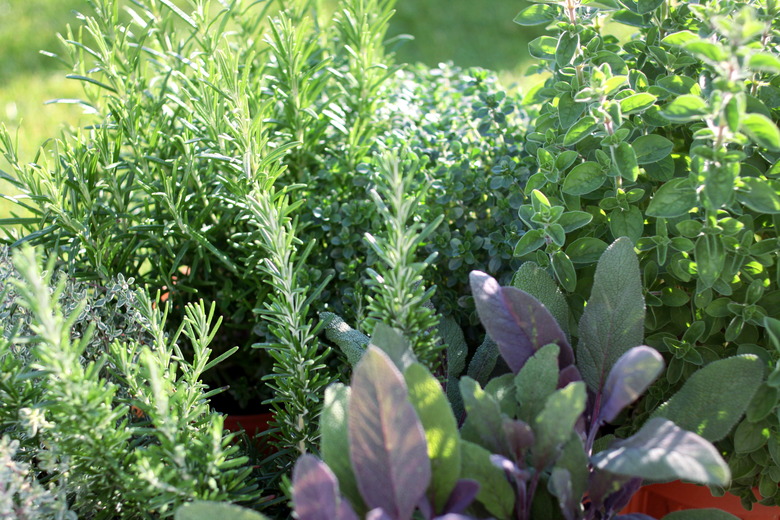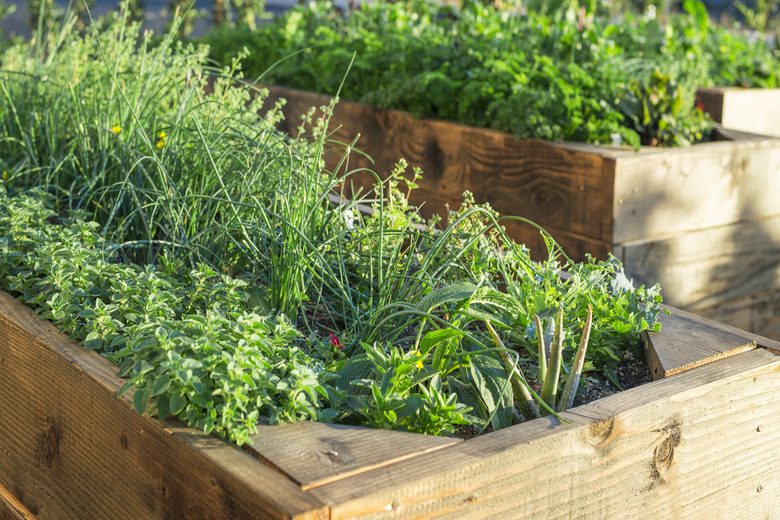How To Plant An Herb Garden
We may receive a commission on purchases made from links.
Even if you don't have a green thumb, you can have a low-maintenance DIY herb garden. Most culinary herbs are so easy to grow that they almost thrive on neglect, which is good news for the forgetful gardener. You may not enjoy (or simply don't have time for) the care that's required to grow many landscape plants successfully. If this resonates with you, you'll love the minimal intervention needed for many herbs because of their drought tolerance, pest resistance, and low fertility needs.
Whether you plant a dedicated herb garden or you incorporate herb plants into your landscape design, the ultimate payoff is a harvest of fresh herbs to grace your table. Even though most herbs are easy-care plants, observing a few growing tips can optimize your results.
Here's how to plant an herb garden that will keep your meals fresh, your garden fragrant, and your landscape looking lush.
1. Choose the Garden Space Based on Sun and Soil
1. Choose the Garden Space Based on Sun and Soil
As a rule of thumb, most herbs need full sun to prosper (at least six hours of direct sunlight each day), but some herbs grow best in partial shade, particularly during the afternoon. Mint (Mentha spp., USDA zones 3 through 9 depending on species and cultivar), bay laurel (Laurus nobilis, zones 8 through 10) and ginger (Zingiber officinale, zones 9 through 12) are examples of herbs that prefer a partially shaded spot. Know the light requirements of the herbs you're growing so that you can choose the best spot to plant them.
Unlike many landscape plants that need rich, fertile soil, most herbs grow best in average soil. In fact, if you grow herbs in soil with high fertility, the leaves will not be flavorful. The soil must drain well, or herbs will struggle to survive. Most herbs grow best on soil with a pH range of 6.0 to 7.5. Rosemary (Salvia rosmarinus, formerly Rosmarinus officinale, zones 7 through 11) prefers the upper end of this pH range (7.5).
2. Prepare Your Planting Beds
2. Prepare Your Planting Beds
Achieving the balance between loose, well-draining soil and overly fertile soil may be as simple as preparing your herb garden bed to ensure good drainage before you ever plant any herbs. This step is particularly important if you're planting perennial herbs, such as rosemary (Salvia rosmarinus, zones 7 through 11) and oregano (Origanum vulgare, zones 4 through 8), or biennials, such as parsley (Petroselinum crispum), because they'll grow on the same site year after year.
Loosen the soil to a depth of 12 inches or more where you'll be planting herbs and add compost or other organic matter if the soil is heavy. Compost works as a soil conditioner to loosen and aerate the soil, adding only minimal slow-release nutrients (unlike synthetic fertilizer). Planting herbs in raised beds is another option to improve drainage.
Tip
If the soil in your yard is heavy clay or moisture-retentive because of drainage issues, an option to in-ground planting is growing herbs in containers. Always use a container that has a drainage hole and avoid using garden soil in containers; instead, choose a potting mix that is specially blended for growing in containers. Although you'll have to water container herbs more often than those growing in garden beds, you won't have to water them as much as other types of potted plants.
3. Observe Proper Spacing When Planting
3. Observe Proper Spacing When Planting
Although they're tiny and cute when you purchase them in nursery pots, some herbs grow much larger and need to be spaced accordingly. Lemon balm (Melissa officinalis, zones 3 through 7) may grow 2 feet tall, but it has a wider spread (up to 3 feet). Leave enough room between each plant to allow for its mature size, which allows air to circulate around plants and keeps them dry to prevent disease pathogens from reproducing.
4. Water Lightly As Needed
4. Water Lightly As Needed
Use a light hand when watering most herbs. This tip takes you a long way toward establishing a successful herb garden filled with healthy plants. Water most herbs only when the soil is nearly dry. If a finger pressed into the soil detects any moisture 1 inch below the soil surface, wait before watering again. Herbs must also be planted on soil with sharp drainage. Even if you're not supplementing rainfall with manual irrigation, your plants may decline during periods of excessive rainfall.
5. Understand the Fertilizer Requirements for Herbs
5. Understand the Fertilizer Requirements for Herbs
Resist the urge to scatter fertilizer randomly in your herb garden. Average garden soil is generally fertile enough for growing herbs, so apply fertilizer only according to soil-test recommendations, which your local county cooperative extension service can offer based on a soil sample you provide. Some herbs, such as annual basil (Ocimum basilicum), do need a little more fertilizer than others, so be sure and specify which herbs you'll be growing when you submit a soil sample for testing. If you're using a commercially packaged potting soil, choose one that does not contain fertilizer.
Using Herbs in the Landscape
Using Herbs in the Landscape
In addition to having a dedicated herb garden, consider incorporating some herbs into your landscape design.
- Rosemary is a perennial
evergreen shrub that bears tiny white, blue, lavender or purple flowers.
Reaching a mature height between 2 feet and 6 feet depending on cultivar and
climate, rosemary is a suitable sunny-site option to other flowering landscape shrubs. - Oregano (Thymus vulgaris,
zones 5 through 9), grows in a mounding shape that softens sunny walkways as an
edging plant or adds softness to a perennial border or flower bed. - Chives (Allium schoenoprasum,
zones 4 through 8) grows in clumps of vertical, grass-like
foliage that bursts into bloom in spring or summer months with lavender or purple
flowers.
Many gardeners choose to plant their culinary herb garden outside the door of their home that's closest to the kitchen. An herb garden that is located far away in the back of the yard may be more easily forgotten with its out-of-sight, out-of-mind "address." Having your herb garden closer to the house, especially if it's in a spot that you walk by as you enter or leave your home, may tempt you to use the herbs you're growing more often.
Tips on Harvesting Herbs
Tips on Harvesting Herbs
In addition to enhancing your landscape with the addition of an herb garden, you'll also want to grow the most flavorful culinary herbs possible. Giving your herb plants the proper care certainly boosts their health and optimizes their culinary potential. However, knowing when to harvest your herbs is just as important. This timing can really make the difference between bland and flavorful.
If you're growing herbs for their foliage, such as basil, you can harvest the leaves at any time, but when you harvest the leaves just before the plants bloom, you may find that they simply taste better because this is when the essential oils are most concentrated. When harvesting leaves at any other growth stage of an herb plant, pick or cut them in the morning after the dew has dried but before the weather is very hot.
If you're growing certain herbs to harvest their seed pods, such as annual dill (Anethum graveolens), remove the pods when they've turned from green to brown but before they open. Some herbs are grown for their below-ground parts — for example, the rhizomes of ginger. Ginger is a perennial herb but only in USDA zones 9 through 12, so if you're growing ginger outside this perennial range, you'll have to harvest it before the first fall frost. Otherwise, freezing temperatures will damage the rhizomes and ruin your harvest.

